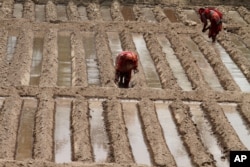The latest farm tools on the job in Pakistan are cell phones and satellites. A new program is using satellite data to estimate how much water a field needs, and then texting this information to farmers.
The hope is to prevent overwatering. A 2013 report from the Asian Development Bank called Pakistan “one of the most water-stressed countries in the world,” with a 30-day storage capacity, well below the recommended capacity of 1,000 days. The per capita water resources are on par with those of Syria, where drought has helped to fuel a civil war.
The water crisis is being driven by several factors: climate change, an expanding population, local mismanagement and a greater demand on farmers. It threatens to destabilize relations between Pakistan and India, who share the Indus River.
Turning off the spigot
Overwatering is costly for farmers trying to make ends meet. While Pakistan continues to suffer from chronic fuel shortages, farmers must use diesel motors to pump groundwater onto their fields. The lower the water table, the more fuel it takes to pump it to the surface.
And overwatering also reduces crop yields. But many older farmers learned their trade at a time when the water ran freely, and the risks of under-watering are so great that farmers still err on the side of too much irrigation. The Pakistan Council of Research in Water Resources (PCRWR) found that rice farmers were using more than three times as much water as they needed to.
The PCRWR reached out to the Sustainability, Satellites, Water, and Environment research group (SASWE) at the University of Washington, hoping to use science to inform irrigation choices.
Pakistan's program started last spring with a 700-farmer pilot. As of January, 10,000 farmers were receiving messages like this one: "Dear farmer friend, we would like to inform you that the irrigation need for your banana crop was 2 inches during the past week."
The messages come from a fully-automated system that does everything from downloading publicly available satellite data and distributing the text messages to using models to compute how much each farmer needs to irrigate.
A nationwide effort
PCRWR plans to scale up the program for use across the nation, and expects millions of farmers to participate. But first they are reviewing the system. They want to know how easy it is for farmers to use, and how many actually follow the irrigation advisories. And they want to know how accurate it is and how effective it is at saving farmers money.
They are collecting feedback from farmers over the phone.
“I haven't seen any report yet,” Faisal Hossain of SASWE told VOA, but “we got a story last month from one of the farmers who was telling us how he was able to get, I think, for every acre 700 kilograms more of wheat than his neighbor.” The farmer credited the irrigation advisories.
There are challenges to expansion. They may need to do more work to persuade farmers to trust the technology. As more farmers use it on smaller farms in areas with more varied terrain, the satellite data resolution may not be precise enough for accurate measurements. And small farmers may not be comfortable relying on cell phone technology.
But for the most part, cell phones already are fairly ubiquitous in Pakistan. Last year, the Punjab government reported that it would be giving out 5 million smartphones to farmers.








